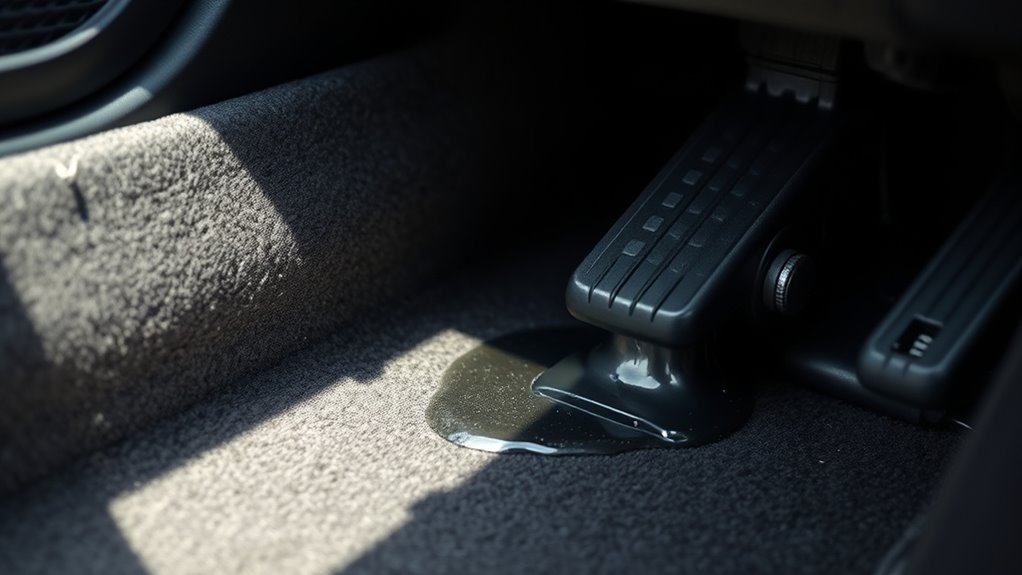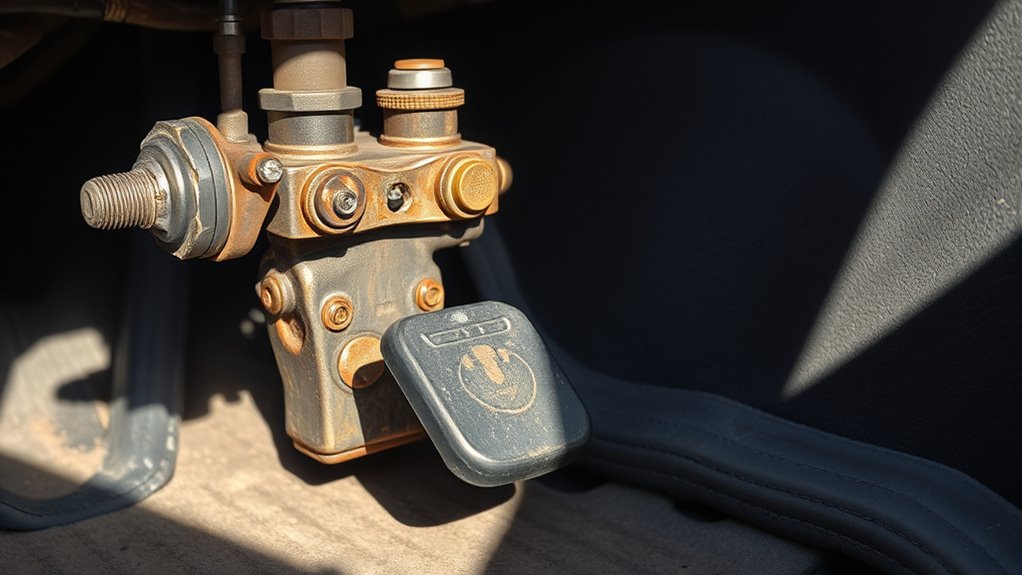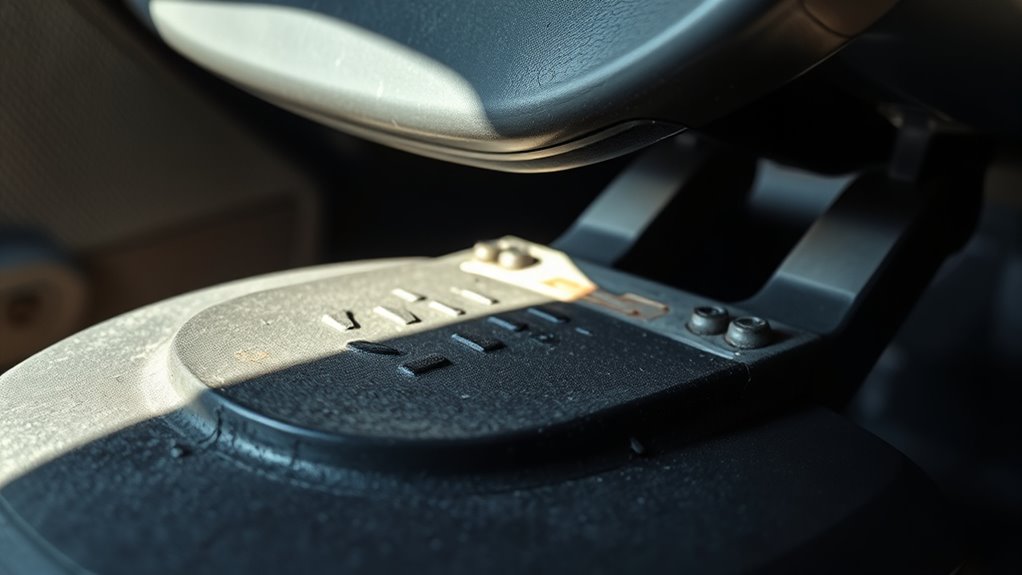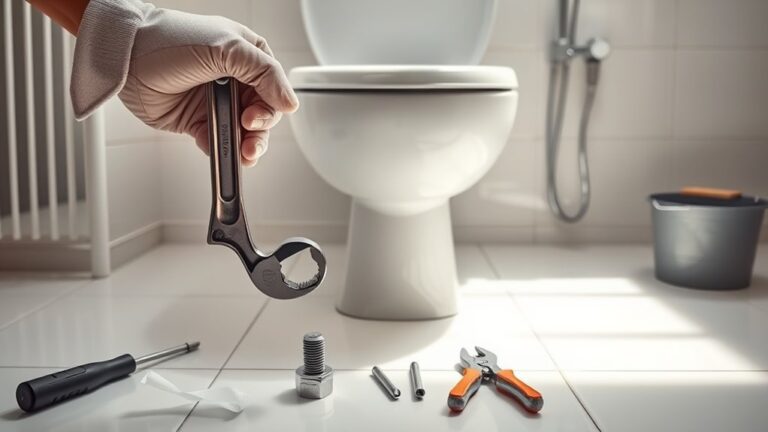If your brake pedal sinks to the floor, it usually means there’s a serious hydraulic issue like a brake fluid leak, air in the brake lines, or a failing master cylinder. These problems reduce hydraulic pressure, causing the pedal to lose resistance and compromising your braking safety. Worn brake pads or brake booster faults may also contribute. You’ll want to understand how these failures affect your vehicle and what steps you can take next to restore optimum brake performance.
Common Causes of a Brake Pedal Sinking to the Floor

Although a brake pedal sinking to the floor can indicate several issues, the most common causes typically involve problems with the hydraulic system, such as a leak in the brake lines or a failing master cylinder. When you press the brake pedal, hydraulic pressure transmits force through brake fluid to engage the brake pads. If the hydraulic pressure drops due to compromised components, your brake pedal will lose resistance and travel further than usual. A failing master cylinder can allow internal fluid bypass, reducing pressure despite no external leaks. Similarly, air trapped in the brake lines disrupts hydraulic pressure, causing a spongy pedal feel that may sink. Understanding these issues helps you maintain control and freedom on the road by ensuring your braking system operates reliably and safely.
How Brake Fluid Leaks Affect Pedal Pressure
Brake fluid leaks directly impact the hydraulic pressure needed for effective braking, causing your pedal to lose resistance and sink toward the floor. When brake fluid escapes from the system, it reduces the volume of fluid available to transmit force from the pedal to the brake calipers or drums. This drop in fluid level decreases pedal pressure, making it harder for you to slow down or stop your vehicle safely. Even a minor leak can introduce inconsistencies in pressure, resulting in a spongy or sinking pedal feel. Identifying and repairing brake fluid leaks quickly is essential to restore proper pedal pressure and maintain reliable braking performance. Ignoring leaks compromises your freedom to drive with confidence and control, increasing the risk of brake failure during critical moments.
The Role of Air in the Brake Lines

How does air get into your brake lines, and why does it matter? Air can enter through leaks, during fluid replacement, or from worn seals. Even a tiny air bubble inside the brake lines compromises brake efficiency because air compresses under pressure, unlike brake fluid. When you press the pedal, instead of hydraulic force directly activating the brakes, the air bubble compresses, causing the pedal to travel further—sometimes all the way to the floor. This loss of direct hydraulic pressure reduces your control and increases stopping distance, threatening your freedom on the road. To restore full brake efficiency, you need to remove these air bubbles through proper bleeding procedures, ensuring the hydraulic system remains airtight and responsive every time you apply the brakes.
Worn Brake Pads and Their Impact on Pedal Feel
When your brake pads wear down, the pedal feel changes noticeably because the pads can’t generate sufficient friction to stop the vehicle effectively. Worn pads reduce the contact surface between the brake rotor and pads, forcing the caliper piston to extend further to engage braking. This extended travel translates into a softer, lower brake pedal feel, sometimes causing the pedal to sink closer to the floor. You might also experience diminished braking responsiveness or longer stopping distances. Monitoring brake feel is essential; a spongy or sinking pedal often signals worn pads needing immediate replacement. Ignoring worn pads compromises your control and freedom on the road, risking safety. Regular inspection and timely maintenance guarantee your brake system maintains peak performance and preserves pedal feel integrity.
Master Cylinder Failure and Brake Pedal Issues

Although you might not immediately suspect it, a failing master cylinder is a common cause of brake pedal issues, including the pedal sinking to the floor. The master cylinder is responsible for generating hydraulic pressure that translates your pedal effort into braking force. When internal seals wear out or fluid leaks occur, the master cylinder can’t maintain pressure, leading to a loss of brake performance. You may notice the pedal gradually losing resistance or abruptly dropping to the floor despite your input. This failure compromises your control and freedom on the road, making it critical to address promptly. Diagnosing master cylinder problems involves checking for fluid leaks and pedal feel changes. Replacing a faulty master cylinder restores reliable brake performance and guarantees your safety.
Diagnosing Problems With the Brake Booster
Besides the master cylinder, the brake booster plays a key role in pedal feel and braking efficiency. When diagnosing brake booster issues, focus on vacuum pressure and the booster’s integrity. A failing booster often leads to a hard pedal or one that sinks.
| Symptom | Possible Cause | Diagnostic Step |
|---|---|---|
| Hard brake pedal | Loss of vacuum pressure | Check vacuum hose for leaks |
| Pedal sinks slowly | Internal diaphragm leak | Perform booster vacuum test |
| Hissing noise when pressed | Faulty check valve | Inspect check valve function |
You can test vacuum pressure with a gauge; insufficient vacuum reduces assist, making the pedal harder to press. Ensuring the brake booster’s vacuum system is intact restores pedal firmness and safe braking freedom.
How to Check for Brake Line Damage
Since brake lines are essential for transmitting hydraulic pressure, any damage can severely impair your vehicle’s braking performance. To check for brake line damage, start with a thorough line inspection. Look along the entire length of each brake line, focusing on areas prone to corrosion, cracks, or kinks. Use a flashlight to spot any wet spots indicating brake fluid leaks, as even a small leak compromises system pressure. Gently run your fingers along the lines to feel for bulges or soft spots, signs of internal failure. Remember, damaged lines will cause brake fluid loss, reducing hydraulic force and causing the pedal to sink. If you detect any damage or fluid presence, avoid driving and address the issue immediately to retain control and freedom on the road.
Steps to Bleed Your Brakes Correctly
To bleed your brakes correctly, start by gathering the necessary tools, including a wrench, clear tubing, and fresh brake fluid. You’ll need to follow the proper bleeding order—usually starting with the wheel farthest from the master cylinder—to guarantee all air is removed. Throughout the process, keep a close eye on the brake fluid levels to prevent introducing new air into the system.
Gather Necessary Tools
Before you begin bleeding your brakes, you’ll need a few essential tools to guarantee the process is efficient and effective. Proper brake maintenance demands the right tool essentials to avoid errors that compromise safety. Start with a clear, high-quality brake fluid compatible with your vehicle. A brake bleeder kit, which includes a hose and a catch bottle, allows you to expel air without contamination. You’ll also need a wrench set tailored to your brake bleeder valves, ensuring a secure fit. A sturdy jack and jack stands will safely lift and stabilize your car. Additionally, keep lint-free rags and gloves on hand to maintain cleanliness and protect yourself. Having these tool essentials prepared grants you the freedom to perform brake bleeding confidently and correctly.
Follow Proper Bleeding Order
Although bleeding brakes might seem straightforward, following the proper sequence is essential to confirm all air is expelled from the system. Proper bleeding guarantees your brake pedal won’t sink to the floor, giving you full control and freedom on the road. The brake order typically follows the longest brake line first, moving toward the shortest. Here’s the standard brake order you should follow:
- Start with the brake farthest from the master cylinder (usually the right rear).
- Move to the brake diagonally opposite (left rear).
- Then the brake on the right front.
- Finish with the brake closest to the master cylinder (left front).
Adhering to this brake order maximizes effectiveness, removes trapped air, and restores pedal firmness.
Check Brake Fluid Levels
Maintaining the correct brake fluid level is critical for effective bleeding and overall brake performance. Before you start, check the brake fluid reservoir—low fluid compromises hydraulic pressure and can introduce air into the system. Proper brake fluid maintenance prevents fluid contamination causes like moisture or debris, which degrade braking efficiency and safety.
| Fluid Level Status | Implication |
|---|---|
| Full | Ideal hydraulic pressure |
| Low | Risk of air ingress, spongy pedal |
| Contaminated | Compromised braking, system failure |
Always use the manufacturer-recommended fluid type to avoid chemical incompatibility. Keep the reservoir cap tightly sealed to maintain fluid integrity. Address any leaks promptly to guarantee your braking system remains reliable, safe, and grants you the freedom to drive confidently.
When to Seek Professional Brake System Repair
How do you know when it’s time to call a professional for brake system repair? Recognizing warning signs early guarantees your freedom on the road and prevents further damage. Despite regular brake system maintenance, certain issues demand expert intervention. Look out for these key indicators:
- Brake pedal consistently sinks to the floor even after adding brake fluid.
- Noticeable brake fluid leaks underneath your vehicle.
- A spongy or unresponsive brake pedal during operation.
- Warning lights on your dashboard related to brake system faults.
If you experience any of these, avoid delay. Professional technicians possess the diagnostic tools and expertise to safely address complex hydraulic or mechanical failures. Timely repair safeguards your control, prevents accidents, and maintains peak brake performance. Don’t compromise your freedom—act at the first clear warning sign.




